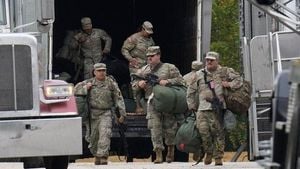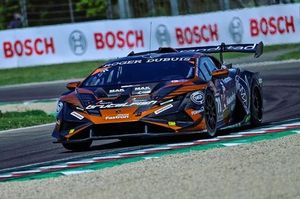NASA astronauts Butch Wilmore and Sunita Williams currently await their return from the International Space Station (ISS), having intended to spend only eight days there. Unexpectedly, their stay has turned to eight months after Boeing's Starliner spacecraft, intended for their safe return, presented various issues, including fears of safety related to the craft. Scheduled to head back to Earth many months earlier, the two astronauts find themselves adjusting to life above our planet well past their expected timeline, with the potential return slated for 2025.
When Wilmore and Williams embarked on their mission, they were part of a test flight for the Boeing Starliner, which took off on June 5, 2024. Little did they know how significant the upcoming months would be. The launch, meant to demonstrate the spacecraft's capabilities, faced multiple technical difficulties before and during take-off, prompting mission control at NASA to delay their return.
Turmoil surrounded the Starliner, and as it became clear the astronauts wouldn’t be flying back with it, both Wilmore and Williams had to prepare for what would be their extended stay. They are now sharing the ISS with nine other crew members, adapting to the daily routines of life among the stars. To their surprise, they describe their time spent aboard as enjoyable, even calling it their “happy place.”
"We’re safe here; it’s our home for now," said Williams, reflecting on their surroundings and the vibrant community of astronauts with whom they share this unique experience. Both Wilmore and Williams stress the importance of communication back to Earth, emphasizing the connection they maintain with their families and friends. Television and other distractions help alleviate the effects of being stranded among the stars.
Meanwhile, preparations for the upcoming U.S. election are taking shape. The two astronauts plan to cast their ballots from space, following established protocols for off-Earth voting. NASA has facilitated astronaut participation since 1997, allowing them to request and submit electronic ballots during their time away from home. Both astronauts expressed gratitude for this opportunity to engage civically, even from 400 kilometers above Earth's surface. "I sent down my request for a ballot today," Wilmore noted. "It's very important for us to participate as citizens."
Despite concerns about getting home, both astronauts share enthusiasm about their situation on the ISS. Both experienced long-standing careers as astronauts and have faced many challenging missions. They take comfort knowing they have trained for years to experience long-duration flights.
Part of the challenge has been maintaining health and fitness during their extended stay. The crew exercises daily, investing time to combat the effects of living under microgravity. With exercise regimes built around treadmill running, resistance training, and cycling, astronauts do their best to remain physically fit. Crew members are also subjected to medical monitoring, ensuring they remain healthy throughout this unusual mission.
Life aboard the ISS requires making do with limited resources. The lack of laundry facilities means clothing must be worn for weeks at a time, resulting significantly more than what astronauts may be accustomed to on Earth. Williams remarked, "We wear the same clothing for weeks; it’s all part of the process. Clothes are sent back to Earth with supply vehicles or burned up upon re-entry."
Food options present another challenge. Meals are primarily reconstituted freeze-dried packs, which can feel underwhelming after months of consumption. Wilmore suggested their food can be likened to camping rations, stating, "It was enjoyable but can always be healthier." Celebrity chef Laurent Gras has prepared some specialty packs for the astronauts, providing some excitement for mealtime.
The astronauts’ daily lives revolve around planned schedules from mission control, with time dedicated to maintenance, experiments, and exercise. On off days, they enjoy bonding with crewmates, singing, conducting science experiments, or taking video calls with friends and family. Alongside the scientific responsibilities at hand, their work routine can be highly fulfilling.
Yet, common challenges arise—like dealing with the unique vacuum of space. Williams pointed out "space smell" as one remarkable aspect of their environment; it’s something they progressively acclimate to. Fellow astronauts have humorously described it as metallic, likely because of the interaction between oxygen and higher radiation levels outside the station.
The astronauts also find themselves involved actively with updates back on Earth, experiencing support from the NASA community. Doctors and engineers closely collaborate to monitor any changes or effects the microgravity environment might have on their bodies. They undergo tests to study the impacts of space on human physiology, hoping those results contribute to wider knowledge about long-term space travel.
With the ISS being described as about the size of Buckingham Palace, Wilmore explained how they can exist and work within such vastness. He pointed out, “It is peaceful; it is like being on many buses all bolted together, yet you can go hours without seeing another crewmate.”
Although they miss significant life events back home, both astronauts express pride and comfort finding purpose within their current assignment. Wilmore emphasizes, "We dreamed our whole lives for opportunities like this, and here we are, making the most out of every single day stranded together. Every challenge is just another part of our adventure."
NASA continues to navigate the many logistics concerning the delayed return of the stranded astronauts. Wilmore and Williams are slated to switch rides with the arriving SpaceX crew members, marking at least eight months spent aboard the ISS before they finally exit back to Earth.
While challenges linger, joy and purpose remain at the forefront for both Wilmore and Williams. They’ve grown both personally and professionally during their extended mission. Preparing to leave their unique home, they are eager to contribute to scientific expertise, helping pave roads for future exploration as NASA moves forward with its ambitious agenda.



